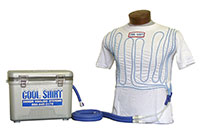Buying a water-circulation driver cooling system may seem overwhelming at first because there are so many choices to make. On top of that, everything is sold separately. How do you know which parts you need? The purpose of this article is to unravel any confusion and walk you through the various components so you can set up a system that's right for you. |
There are so many parts. Which ones do I need?
A water-cooled shirt system consists of two basic parts: A cooler and a shirt. The Paragon coolers that we sell have an electric pump and fittings already installed. Paragon shirts already have the water-circulating tubing sewn on. Connect the two, add power and cold water, and you're off.
Why can't I just buy a complete system with everything I need?
The short answer is that there is no such thing as a one-size-fits-all system. A Spec Miata running half-hour sprint races in Illinois will have very different needs than a Corvette in the Sebring 12 Hours. What works for a track-day Porsche won't work in a Baja truck. By keeping the major components separate, you get to control the design of your system and customize it to your needs.
What shirt should I get?
Start by deciding whether you are OK with a cotton shirt, or if you want (or are required to wear) a fire-retardant shirt. If cotton is acceptable, pick a color. White is classic but it can look pretty dirty by the end of a race weekend. Black hides dirt a little better, but some people find that black "feels" psychologically warmer.
Cotton shirts also allow you to pick which side the hoses will exit the shirt (Left or Right side). Will the cooler be mounted behind you, or in the passenger seat? (For that matter, which side is your passenger seat on?) Remember that if your suit doesn't have a buttonhole exit opening for the tubes, you will have to route the tubing through the zipper.
How do I know what shirt size to order?
Order the same size shirt that you would normally wear for an undershirt. Water-cooled shirts fit a little snug, but that helps to keep the tubing in contact with your skin.
I've picked out a cooler and a shirt. What else do I need?
This depends on your installation. The most common addition to any system is a hose kit. This simply extends the reach from the cooler to the shirt. Again, not everyone needs a hose kit. (Note that there is also a 2-person Y-hose for rally use. If the driver is alone in the car, choose the standard hose kit.) Paragon offers hoses in several different lengths, so you can choose the length that suits your installation.
A mounting tray will make installation of a hard-sided Viking series cooler easier, but some people prefer to build their own tray. Or maybe you just bought a racecar that already has a tray in place. The soft-sided bag coolers don't use a mounting tray.
My system is supposed to provide 3 hours of cooling. Why did the water get warm after just an hour?
First, a little background theory: Heat transfer rates are greatly affected by the surface area exposed to the heat source. In this case, the heat source is the water that has just circulated through the shirt next to the driver's body. The ice in the cooler is there to absorb the heat from the water. The more surface area the ice has (relative to the mass of the ice), the faster the heat will transfer from the water to the ice. As the ice absorbs heat, it melts. Eventually, the melted ice will reach the point where it can't absorb any more heat because it is basically the same temperature as the water coming from the shirt. That's when the cooling stops.
You can extend the cooling time by slowing down the heat transfer rate. You do this by raising the mass-to-area ratio: Decrease the amount of exposed surface area and/or increase the mass of the heat absorber. In other words, a single large block of ice will last longer than many small ice cubes. The "up to x hours of cooling" rating assumes the use of large blocks of ice, not small ice cubes. The absolute worst for our purposes is the ice "tubes" sold at many gas stations. They'll cool your drink down in a big hurry, but they have almost twice as much surface area as a similarly-sized solid cube, with even less mass. (Okay, you could actually do worse than tubular ice: Crushed ice. That belongs in your margarita, not in your cool suit system.)
Where am I supposed to buy block ice from? Am I out of luck if I can't find it?
Some ice vendors sell block ice right next to the cubes, but not all do. There's also the question of whether their block of ice will fit in your cooler. But there are alternatives.
A very effective substitute for ice cubes or blocks is a freezer pack, similar to what you might use in your food cooler. Cool Shirt offers soft-sided Endurance Ice Freezer Packs in multiple sizes. Use a larger size for longer races. Fill the cooler with as many ice packs as you can, then top off with water.
One more tip to keep the system cooling longer: Try adding a control switch or rheostat. Slowing the pump down can help to slow the heat transfer rate, which will keep the ice frozen longer.
What should I do with the system between races?
First, always use the recommended Paragon Defense Solution additive in the water. This additive inhibits algae growth while also lubricating the pump. Dump the water out of the cooler as soon as you get home from the track (or before you leave the track, if you have a long tow ahead of you). Leaving the water sitting too long can encourage algae growth. Drain the shirt and hoses between races.


